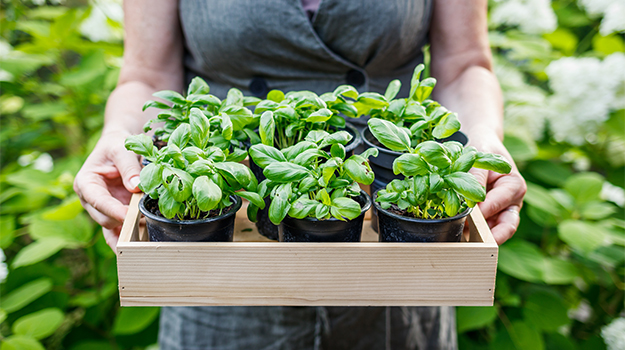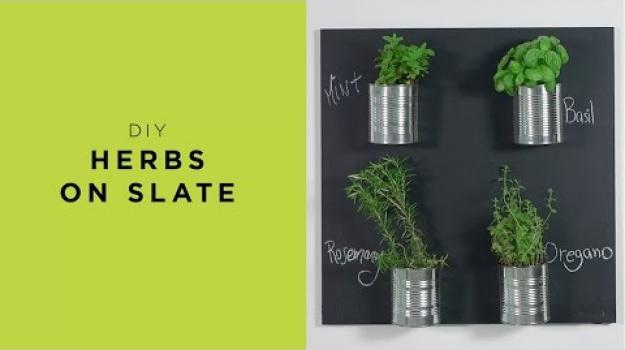
If you ask gardeners about their favourite herb, basil is nearly always on the top of the list. Why? It’s easy to grow and it adds a subtle but distinctive flavour to a number of foods, including meat dishes, soups, sauces, salads, pasta. Basil can even be transformed into butter, vinegar and of course, pesto.
Growing basil

Basil requires rich, fertile, well-drained soil and full sunlight. This Mediterranean herb doesn’t do well in temperatures below 15 °C and may be damaged below 10 °C.
Basil can be grown in a container or veggie garden. In a container, use a quality soil promoting water and nutrient uptake. Enriched with sphagnum peat moss and a growth enhancer, PRO-MIX Premium Organic Vegetable and Herb Mix will feed your plant for up to 3 months.
Sow basil seeds directly in the garden after the soil has warmed and all danger of frost has passed. Dig or till the soil to a depth of at least 6 to 8 inches (15-20 cm), then work in a generous amount of compost or well-rotted manure before planting, along with a small amount of PRO-MIX Organic-Based Multi-Purpose Garden Fertilizer 12-6-6.
Cover the seeds with no more than ¼ inch (0.5 cm) of soil. Alternatively, plant seeds indoors three to four weeks before the last expected frost.
How to grow a beautiful basil plant

- Thin basil to a spacing of 3 to 4 inches (8-10 cm) when the seedlings have two to three pairs of leaves, not counting the tiny seedling leaves. Continue to thin the plants as they grow. By the time the basil is mature, the plants should be spaced about 12 inches (30 cm) apart.
- Pinch growing tips regularly to encourage healthy, bushy growth.
- Remove flower buds as soon as they form. Allowing flowers to remain on the plant will diminish the flavour.
- Water basil deeply every 7 to 10 days. If you’re growing basil in containers, you’ll need to water more often – possibly every day if the weather is hot and dry.
- Once or twice during the growing season, provide a light application of balanced, general-purpose fertilizer such as PRO-MIX Organic-Based Multi-Purpose Garden Fertilizer 12-6-6. If you’re growing in containers, use a water-soluble fertilizer such as PRO-MIX Premium Organic-Based Garden Fertilizer for Tomatoes, Vegetables & Fruits 9-16-16 every three to four weeks, diluted to half strength.
- Remove weeds as soon as they appear by scraping the soil carefully with a hoe. Don’t allow weeds to remain because they will use water and nutrients your plants need.
Harvesting basil

Here’s how to cut your basil plant so it grows back. At the beginning of the season, harvest a few individual basil leaves from small plants as needed. Thereafter, harvest whole leaves and stems, using scissors or a knife. You should see new growth emerge in about a week.
OUR TIP: Cut your plant’s head when harvesting leaves. This will stimulate branching and it will produce more leaves!
How to get a basil plant to survive

Basil isn’t a perennial. Very sensitive to the cold, it often dies at the first sign of frost. There’s no use in trying to keep it indoors as it is unlikely to survive the shock. It’s better to start new plants indoors.
Although it won’t produce as much as in summer, it’s easy to grow basil indoors. For a constant harvest, start seeds every other month; indoors, basil begins to etiolate after three months, regardless of the care you give it. All you need is a packet of seeds and a little soil to grow basil all year.
Must-try recipe: Basil pesto

Basil can be used in many different ways, but pesto is definitely one the first that comes to mind and one of the most popular. It’s easy to cook and you can make as much as you want when your harvest is more bountiful than expected. What’s more, it takes no time at all and requires only a few ingredients!
In a food processor, grind ¼ cup of fresh parmesan, ¼ cup of pine nuts (or walnuts for a more economical version) and a clove of garlic. Add 2 cups of basil, ½ cup of olive oil and the juice of a quarter of a lemon. Season with salt and pepper and mash to a smooth purée.
OUR TIP: If you use a blender, choose regular virgin olive oil (over extra virgin) to avoid bitterness. Pesto can be frozen in an ice cube tray. Once frozen, simply put the cubes in an airtight bag.


